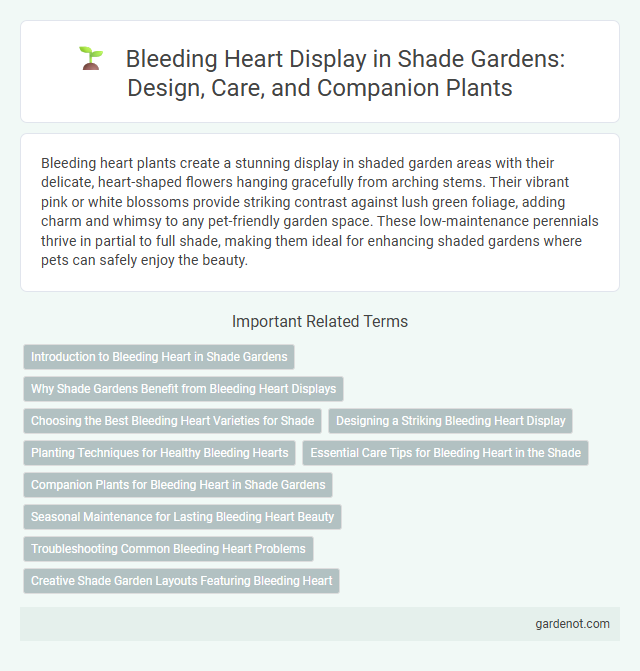Bleeding heart plants create a stunning display in shaded garden areas with their delicate, heart-shaped flowers hanging gracefully from arching stems. Their vibrant pink or white blossoms provide striking contrast against lush green foliage, adding charm and whimsy to any pet-friendly garden space. These low-maintenance perennials thrive in partial to full shade, making them ideal for enhancing shaded gardens where pets can safely enjoy the beauty.
Introduction to Bleeding Heart in Shade Gardens
Bleeding heart (Dicentra spectabilis) thrives in shade gardens, offering delicate, heart-shaped pink or white flowers that dangle gracefully from arching stems. This perennial prefers moist, well-drained soil and filtered sunlight, making it ideal for woodland settings or shaded borders. Its unique bloom structure and early spring flowering period add texture and color to shaded garden areas.
Why Shade Gardens Benefit from Bleeding Heart Displays
Bleeding heart plants thrive in shade gardens due to their preference for cool, moist environments, adding vibrant pink or white heart-shaped blooms that enhance under-canopy aesthetics. These perennial plants provide extended seasonal interest from spring through early summer, attracting pollinators like hummingbirds and bees crucial for a healthy garden ecosystem. Their delicate foliage complements ferns and hostas, creating layered textures that maximize shade garden visual appeal while requiring minimal maintenance.
Choosing the Best Bleeding Heart Varieties for Shade
Select bleeding heart varieties such as Dicentra spectabilis and Dicentra eximia for optimal performance in shade gardens, as they thrive in low-light conditions. These varieties offer vibrant pink, white, or red heart-shaped flowers that brighten shaded areas while tolerating moisture-retentive soils. Prioritize cultivars like 'Gold Heart' and 'Valentine' for unique foliage colors and extended blooming periods under shaded canopies.
Designing a Striking Bleeding Heart Display
Designing a striking Bleeding Heart display involves selecting rich, well-drained soil and positioning the plants in partial to full shade to mimic their natural woodland habitat. Incorporate contrasting foliage like ferns and hostas to highlight the delicate, heart-shaped blooms of Dicentra spectabilis. Spacing plants 12 to 18 inches apart ensures optimal air circulation and a lush, cascading floral effect throughout the spring season.
Planting Techniques for Healthy Bleeding Hearts
Plant bleeding hearts in well-drained, fertile soil rich in organic matter to promote vigorous growth and vibrant blooms. Ensure partial to full shade exposure to mimic their natural woodland habitat, preventing leaf scorch and encouraging healthy foliage. Regular watering and mulching help maintain consistent moisture levels, reducing stress and supporting robust plant development.
Essential Care Tips for Bleeding Heart in the Shade
Bleeding heart thrives in well-drained, humus-rich soil with consistent moisture to prevent wilting and root rot in shaded garden areas. Maintaining a cool, shaded environment protects the delicate, arching flowers from direct sunlight that can cause leaf scorch. Regularly removing spent blooms encourages prolonged flowering and supports overall plant health in shade gardens.
Companion Plants for Bleeding Heart in Shade Gardens
Bleeding heart thrives in shade gardens alongside hostas, ferns, and astilbes, which complement its delicate, arching blooms with varying leaf textures and heights. These companion plants enhance soil moisture retention and provide a lush backdrop, amplifying bleeding heart's vibrant pink or white flowers. Incorporating woodland phlox and Solomon's seal further diversifies the garden's structure, supporting a balanced ecosystem and extending seasonal interest.
Seasonal Maintenance for Lasting Bleeding Heart Beauty
Bleeding hearts thrive in shaded garden areas with rich, well-drained soil and require consistent moisture to maintain their delicate blooms throughout the growing season. Regular removal of spent flowers and yellowing foliage encourages prolonged flowering and reduces the risk of fungal diseases common in damp environments. Applying a balanced, slow-release fertilizer during early spring supports healthy growth and vibrant displays, ensuring lasting beauty in your shade garden.
Troubleshooting Common Bleeding Heart Problems
Yellowing leaves and wilting often indicate overwatering or poor drainage in bleeding heart plants, requiring improved soil aeration. Aphids and slugs are common pests that damage foliage; treating with insecticidal soap or natural predators helps restore plant health. Fungal diseases such as powdery mildew appear as white coatings on leaves and can be managed through proper spacing and fungicide applications.
Creative Shade Garden Layouts Featuring Bleeding Heart
Bleeding heart (Dicentra spectabilis) thrives in creative shade garden layouts, adding delicate, heart-shaped blooms that enhance visual interest under tree canopies or along shaded borders. Its graceful arching stems and soft pink or white flowers provide a romantic focal point in layered planting designs combining hostas, ferns, and astilbes. Integrating bleeding heart into shade gardens supports biodiversity by attracting pollinators like hummingbirds and bees, while maintaining a lush, textured understory.
Bleeding heart display Infographic

 gardenot.com
gardenot.com